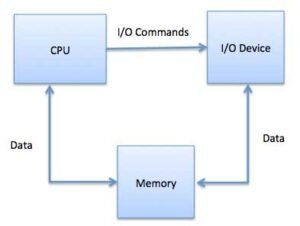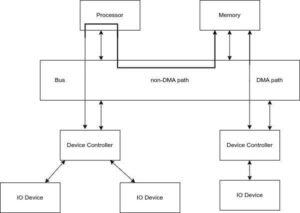I/O Devices & Controllers
In a computer system, Input/Output (I/O) devices enable interaction between the system and the external world. These devices allow users to input commands and receive results, or connect the system to other hardware. To manage this communication, the system uses dedicated hardware units known as I/O Controllers.
Understanding the architecture of I/O devices and controllers is essential for analyzing system performance, hardware compatibility, and communication efficiency.
What are I/O Devices?
I/O devices are hardware components used to either send data into a computer (input), receive data from a computer (output), or both (input/output).

Examples:
- Input Devices: Keyboard, mouse, scanner, microphone
- Output Devices: Monitor, printer, speaker
- Input/Output Devices: Hard drives, network cards, USB flash drives
These devices have varying data rates, access methods, and timing requirements, so the operating system must handle them differently.
The Role of I/O Controllers
An I/O Controller acts as a bridge between the CPU and the I/O device. Since the CPU cannot communicate directly with most hardware, controllers manage the details of communication and device-specific protocols.

Each type of device typically has its own controller (e.g., Disk Controller, Keyboard Controller, Display Controller).
Functions of I/O Controllers:
- Interpret device-specific signals
- Manage data transfer between memory and device
- Handle communication protocols (e.g., USB, SATA, PCIe)
- Send and receive control signals from the CPU
- Use buffers and registers to queue and manage data
Controllers allow the CPU to offload the complexities of device communication, improving efficiency and modularity.
Communication Between CPU and Devices
The CPU interacts with I/O controllers using the following mechanisms:
- Polling: The CPU repeatedly checks the status of the device. This method is simple but inefficient for frequent checks.
- Interrupts: The device notifies the CPU when it’s ready for attention. This is more efficient than polling and allows the CPU to work on other tasks in the meantime.
- Direct Memory Access (DMA): The controller can access memory directly without involving the CPU during data transfer. This method greatly increases the speed of I/O operations.
Port-Mapped vs Memory-Mapped I/O
- Port-Mapped I/O (Isolated I/O): Uses a separate address space for I/O devices. Requires special instructions for access.
- Memory-Mapped I/O: Treats device registers as if they were part of the regular memory space. Allows standard read/write operations.
Modern systems often use memory-mapped I/O for easier and faster access to device data.